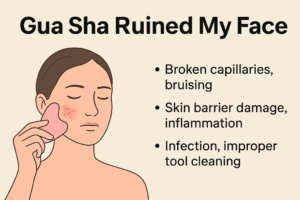Plastic gua sha, metal gua sha, natural stone gua sha, etc. More and more materials are beginning to be used in gua sha tools, with the popularity of gua sha. So for different materials, safety issues are people’s primary consideration. Among them, the question of whether plastic gua sha safe is the most frequently mentioned among all gua sha materials. This is generally related to the common perception of plastics in people. Plastics are made from a variety of different chemical raw materials, many of which are harmful to the human body. So:
Is Plastic Gua Sha Safe?

Normally it is safe. There are two main aspects that determine of plastic gua sha safe: 1. The safety of the material. 2. Whether the processing technology meets safety standards.
- From a safety perspective, regular gua shamanufacturers often use high-quality, safe plastic raw materials as raw materials for making gua sha Although these raw materials may not meet the standards of food-grade plastics, the content of toxic substances contained in them is within the requirements of national or international standards. Therefore, the plastic gua sha safe sold through regular channels and manufacturers is trustworthy.
- From the aspect of processing technology. It is much easier to make a gua sha tool using plastic than using stone, metal and other materials. When plastic melts, its high plasticity and ductility allow it to be easily molded into a specific shape. For stone materials, it needs to be cut and polished by machine or manually. This results in a large error value between different gua sha Therefore, from the perspective of existing processing technology, plastic gua shatools are safe and reliable.
So when you purchase a plastic gua sha tool from regular channels and merchants, you don’t have to worry too much about its safety. However, there are also many businesses that use substandard materials to make gua sha tools.
How to Tell Whether the Plastic Gua Sha Safe?
There are several factors to consider when evaluating the safety of the raw materials used in plastic gua sha tools. Here are some steps you can take to evaluate the safety of these materials:
- Research the type of plastic used: Determine the specific type of plastic used in the gua sha tool. Common plastics include polypropylene (PP), polyethylene (PE), polycarbonate (PC), and acrylonitrile butadiene styrene (ABS). Each type has different characteristics and potential security issues.
- Check for BPA- and phthalate-free certification: Bisphenol A (BPA) and phthalates are chemicals commonly found in plastics that have been linked to health risks. Look for gua sha tools that are clearly labeled “BPA-free” and “phthalate-free.” These certifications indicate that the product does not contain these potentially harmful substances.
- Seek FDA or regulatory approval: Ask if the gua sha tool or its raw materials have been approved by a regulatory agency such as the U.S. Food and Drug Administration (FDA) or the equivalent agency in your country. These approvals typically require rigorous safety assessments.
- Research manufacturer reputation and certification: Research the reputation of the manufacturer or brand that produces the gua sha tool. Look for certifications such as ISO 9001 (demonstrating compliance with quality management standards) or ISO 13485 (specific to medical devices). These certifications increase confidence in the safety of raw materials.
- Read product reviews and customer feedback: Check out online reviews and customer feedback for the specific gua sha tool you’re considering. Look for any reports of adverse reactions or concerns related to the materials used. However, keep in mind that personal experiences may vary.
- Seek expert advice: If you have specific concerns or doubts about the safety of the plastic materials used, consider consulting a healthcare professional, such as a dermatologist or allergist. They may provide additional insight or guidance based on their expertise.
By following the steps above, you can gather information and make a more informed decision about the safety of the raw materials used in plastic gua sha tools.
How Does Plastic Gua Sha Work?
There is no obvious difference in efficacy between gua sha tools made of different materials. The most important factor that determines the effectiveness of a gua sha tool is its shape. Therefore, plastic gua sha tools can achieve the same results as gua sha tools made of other materials. So what can a gua sha tool do?
- Relieves muscle tension: Gua Sha may help relax tense muscles and relieve muscle stiffness or tension. The gua shamotion targets specific areas of tension, promoting muscle relaxation and reducing discomfort.
- Pain relief: Some people find that gua sha can temporarily relieve pain, such as headaches, neck pain, back pain, or joint pain. The gua shatechnique is thought to stimulate blood flow and release endorphins, which can help reduce pain.
- Improving blood circulation: Gua Sha is believed to enhance blood and lymph circulation. By promoting the flow of fluid, it may help reduce swelling, remove toxins, and support the delivery of oxygen and nutrients to tissues.
- Skin Health Benefits: Gua Sha can improve the appearance and health of your skin. The gua shamotion increases blood flow to the skin, promoting a healthy complexion and potentially reducing the appearance of dullness or puffiness.
- Relaxation and stress reduction: The gentle gua shaand massaging nature of Gua Sha can induce a feeling of relaxation and promote stress reduction. Many people find the process of gua sha soothing and enjoy the self-care benefits of gua sha.
It’s important to note that the experience and benefits of gua sha may vary from person to person. Some people may find it more effective than others, and results may depend on factors such as the specific condition being treated, the technique used, and personal response. It is always recommended to consult a qualified healthcare professional for individualized advice and guidance regarding the use of Gua Sha or any other treatment technique.







